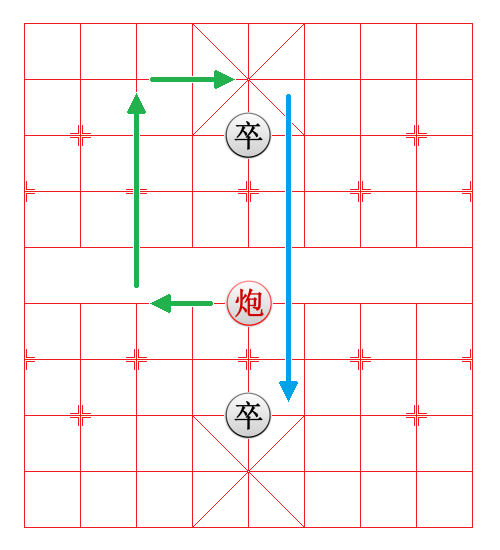DMPG '17 S4 - Artillery Battery
View as PDFOne sunny afternoon, you find yourself in your Geography class watching your teacher Mr. Singh play against a fellow classmate.
Instead of studying for your exams, you decide to visualize the maximum number
Since everybody plays this board game in their spare time, it is common knowledge within the hallways of DMCI that the Cannon is a powerful piece found in both armies. Of course, there is also no need to remind you that there is exactly one of two moves to select from on every turn:
1. Travelling: The Cannon moves any number of tiles horizontally or vertically, ending on an unoccupied tile. It can continue to move as long as it is not obstructed by any pieces and does not exceed the boundaries of the battlefield. The number of pieces on the board remains unchanged.
2. Capturing: The Cannon jumps over exactly one piece (called the screen) on the same rank or file, and must land on the first enemy piece encountered along the same rank or file on the other side of the screen. The captured piece is then removed from the board.
Even if a cannon is in the position to make a capture, the decision to make one is not obligatory.
Note: A rank is a row and a file is a column.
Note: By definition, the only tiles that exist between the screen and the starting and destination tiles of the Cannon must be empty tiles, if there are any at all.
Constraints
Subtask 1 [10%]
Subtask 2 [30%]
Subtask 3 [60%]
There will never be more than
Input Specification
Every input file will contain exactly
Each line will contain
Cdenotes Mr. Singh's Cannon (there will be exactlyEdenotes an enemy piece (there will be.denotes an empty tile
Output Specification
If Mr. Singh is able to capture at least one enemy piece, output the two integers p m.
Here,
If for some strange reason Mr. Singh is unable to capture any pieces using his Cannon, output 0 0.
Sample Input
.........
.........
....E....
.........
.........
....C....
.........
....E....
.........
.........Sample Output
1 4Explanation
The diagram representing one solution to the setup is shown below:
Note that Chinese chess is played on the points of intersecting lines ("tiles") instead of the squares themselves.

Here, the red piece represents the Cannon and the two black pawns represent the opposing team.
The
The
The bottom opposing pawn is captured and removed from the board, and that point becomes the Cannon's new location.
The remaining piece cannot be captured regardless of the legal moves performed by the Cannon, so there is nothing more to be done.
Therefore, the Cannon can capture at most
Comments